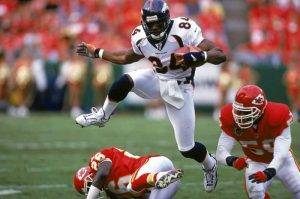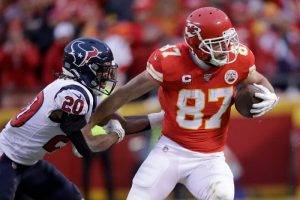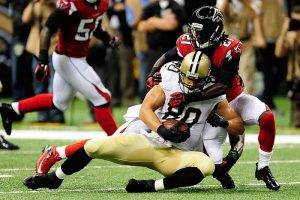In the dynamic realm of football, each position contributes uniquely to the team’s success. One such position, often regarded as a hybrid between offensive linemen and wide receivers, is the tight end. In this comprehensive exploration, we unravel the intricacies of the tight end position, deciphering the roles, responsibilities, and strategic dimensions that define their impact on the gridiron.
Understanding the Foundations: The Evolution of Tight End Play
Historical Perspectives:
The role of tight ends in football has evolved over the years. From traditional blocking-focused responsibilities to becoming integral components of passing offenses, the journey of tight ends reflects the dynamic nature of the sport.
Positional Flexibility:
Tight ends showcase a unique blend of skills, combining the blocking prowess of offensive linemen with the receiving abilities of wide receivers. This positional flexibility allows teams to deploy tight ends in various offensive schemes, creating matchup advantages.
Key Responsibilities: Blocking, Receiving, and Beyond
Blocking Prowess:
One of the primary responsibilities of a tight end is blocking, contributing to both running and passing plays. Whether sealing the edge for a running back or providing protection for the quarterback, tight ends play a pivotal role in the trenches.
Receiving Threat:
Modern football has seen a transformation in the role of tight ends as receiving threats. Their size, agility, and hands make them formidable targets in the passing game, capable of exploiting matchups against linebackers and safeties.
Route Running:
Tight ends must master the art of route running, combining the precision of wide receivers with the physicality required in the middle of the field. Effective route running allows tight ends to create separation from defenders and become reliable targets for quarterbacks.
Strategic Dimensions: Tight Ends as Offensive Chess Pieces
Creating Mismatches:
One of the strategic advantages of tight ends is their ability to create mismatches on the field. Their size can overpower defensive backs, while their speed and agility can outmaneuver linebackers, providing offensive coordinators with a versatile weapon.
Red Zone Impact:
Tight ends often become focal points in the red zone, where their size and catch radius make them valuable targets for scoring opportunities. Teams strategically design plays to capitalize on the tight end’s ability to secure contested catches in tight spaces.
Versatility in Formations:
The presence of a skilled tight end adds versatility to offensive formations. Teams can shift seamlessly between run-heavy sets and pass-oriented spread formations, keeping defenses guessing and adjusting to the multifaceted threat posed by tight ends.
Variations in Tight End Roles: Y, H, and U Tight Ends
Y Tight Ends:
Y tight ends, often referred to as inline tight ends, are typically strong blockers who line up on the line of scrimmage. They play a crucial role in run blocking and pass protection, contributing to the team’s ground game and providing stability in the trenches.
H Tight Ends:
H tight ends, or “move” tight ends, are more versatile in their alignments. They may line up in various positions, including the backfield or in the slot, offering offensive coordinators flexibility in creating mismatches and exploiting defensive vulnerabilities.
U Tight Ends:
U tight ends, sometimes known as “receiving” tight ends, excel in the passing game. Their athleticism, route-running ability, and hands make them primary targets in the aerial attack. U tight ends often stretch the field and contribute significantly to the passing game.
Building Blocks of Tight End Success: Skills and Attributes
Blocking Techniques:
Effective blocking requires tight ends to master a range of techniques, from engaging defenders at the line of scrimmage to executing combination blocks with offensive linemen. A tight end’s ability to contribute in the run game is often a testament to their blocking proficiency.
Catching Ability:
The catching ability of tight ends sets them apart. Soft hands, concentration in traffic, and the capacity to make contested catches elevate tight ends to reliable receiving options. Their catching radius becomes an asset for quarterbacks seeking dependable targets.
Physicality and Size:
The physicality and size of tight ends allow them to navigate the middle of the field, absorbing contact from defenders while maintaining control of the ball. Their stature creates matchup challenges for opposing defenses, especially in one-on-one situations.
Notable Tight End Strategies: Play Action, Bootlegs, and Screen Plays
Play Action:
The threat of tight ends as both blockers and receivers makes play-action passes particularly effective. Quarterbacks can fake a run play, drawing defenders towards the line of scrimmage, and then target tight ends downfield, exploiting the momentarily confused defense.
Bootlegs and Rollouts:
Mobile quarterbacks often utilize bootlegs and rollouts to capitalize on the versatility of tight ends. By moving the pocket and creating off-balance defenses, quarterbacks can find tight ends in open spaces, maximizing their potential as receiving targets.
Screen Plays:
Screen plays involving tight ends are designed to take advantage of their blocking skills and agility. These plays allow tight ends to serve as lead blockers for screens, setting up dynamic plays in open space with the potential for significant gains.
Defensive Challenges: Covering and Countering Tight Ends
Coverage Dilemmas:
Defending against skilled tight ends presents a dilemma for opposing defenses. Matchup challenges arise as teams must decide whether to deploy linebackers, who may struggle with speed, or defensive backs, who may be overpowered physically.
Double-Teaming:
Double-teaming tight ends becomes a defensive strategy to limit their impact. However, this opens up opportunities for other offensive weapons, requiring a delicate balance for defenses to contain tight ends without exposing vulnerabilities elsewhere.
Zone vs. Man Coverage:
Coordinators must decide between zone and man coverage when defending tight ends. Zone coverage provides more eyes on the tight end, while man coverage aims to match physical defenders against their tight end counterparts. The choice depends on defensive personnel and strategic considerations.
Emergence of Dual-Threat Tight Ends: A Game-Changing Trend
Dual Threats in the NFL:
The NFL has witnessed the emergence of dual-threat tight ends who excel in both blocking and receiving. These players, often referred to as complete tight ends, contribute significantly to the success of their respective teams, becoming focal points of offensive schemes.
Matchup Nightmares:
Dual-threat tight ends pose matchup nightmares for defenses, as they can exploit weaknesses in both the run and pass games. Their presence on the field forces opposing coordinators to adapt constantly, making in-game adjustments to counter their multifaceted skills.
Contractual Value:
The rise of dual-threat tight ends has elevated their contractual value in the NFL. Teams recognize the scarcity of players who can impact the game at such a versatile level, leading to lucrative contracts for elite tight ends who can dominate in various facets of play.
Influence of Tight Ends in Crunch Time: Two-Minute Drills and Red Zone Offense
Two-Minute Drills:
Tight ends play pivotal roles in two-minute drills, where clock management and quick, efficient plays are paramount. Their ability to gain separation, move the chains, and create scoring opportunities becomes crucial in high-pressure situations.
Red Zone Offense:
In the red zone, tight ends become go-to targets for quarterbacks seeking to capitalize on their size advantage. The ability to secure touchdowns in the red zone contributes significantly to a team’s overall offensive efficiency and success.
Player Development: Tight End Training and Skill Refinement
Position-Specific Training:
As the role of tight ends continues to evolve, position-specific training becomes essential for player development. Specialized coaching, focusing on both blocking and receiving skills, helps tight ends hone their craft and excel in the multifaceted demands of the position.
Film Study and Mental Preparation:
Tight ends engage in extensive film study to understand defensive tendencies, recognize coverages, and identify potential weaknesses. Mental preparation becomes a crucial aspect of their development, allowing tight ends to make split-second decisions on the field.
Physical Conditioning:
The physical demands placed on tight ends necessitate rigorous conditioning. Balancing strength, speed, and agility is vital for tight ends to navigate the diverse challenges presented by both blocking and receiving responsibilities.
Tight Ends in College Football: A Breeding Ground for Talent
Impact in College Offenses:
The role of tight ends in college football often serves as a precursor to their potential impact at the professional level. College offenses that effectively utilize tight ends as versatile playmakers contribute to the development of future NFL talent.
Draft Trends:
NFL draft trends reveal the value placed on tight ends emerging from college programs. Teams prioritize selecting tight ends with a diverse skill set, capable of making an immediate impact in various facets of the game.
Transition to the NFL:
The transition from college to the NFL presents challenges for tight ends, including adjusting to the increased speed and physicality of the game. Successful transitions often hinge on a tight end’s ability to adapt their skills to the demands of professional football.
Related Post:
How Many Sets Are in Tennis: A Comprehensive Guide to Tennis Set Structure
Navigating the Lanes: A Comprehensive Guide to Bowling Bumpers
Pursuit of NBA Glory: Unraveling the Players with the Most Championship Rings
In the grand symphony of football strategy, the tight end position resonates as a versatile and dynamic melody—a harmonious blend of blocking power and receiving finesse. From the gritty trenches where their blocking prowess shapes the run game to the open spaces where they become matchup nightmares for defenses, tight ends embody the strategic brilliance of the sport.
As the game continues to evolve, the role of tight ends adapts, with dual-threat players redefining the expectations for the position. Whether in crunch time during two-minute drills, orchestrating red zone offenses, or contributing to the development of future stars in college football, tight ends remain integral to the strategic tapestry of the game.
So, whether fans witness a tight end sealing the edge for a game-changing run, executing a flawless route to secure a crucial first down, or elevating their team with a touchdown in the red zone, the symphony of tight end play unfolds—a testament to their enduring influence on the ever-evolving landscape of football strategy.






